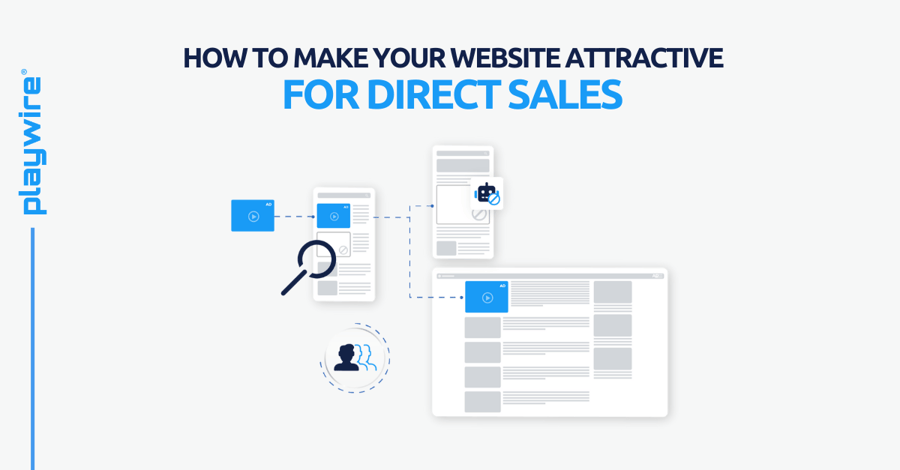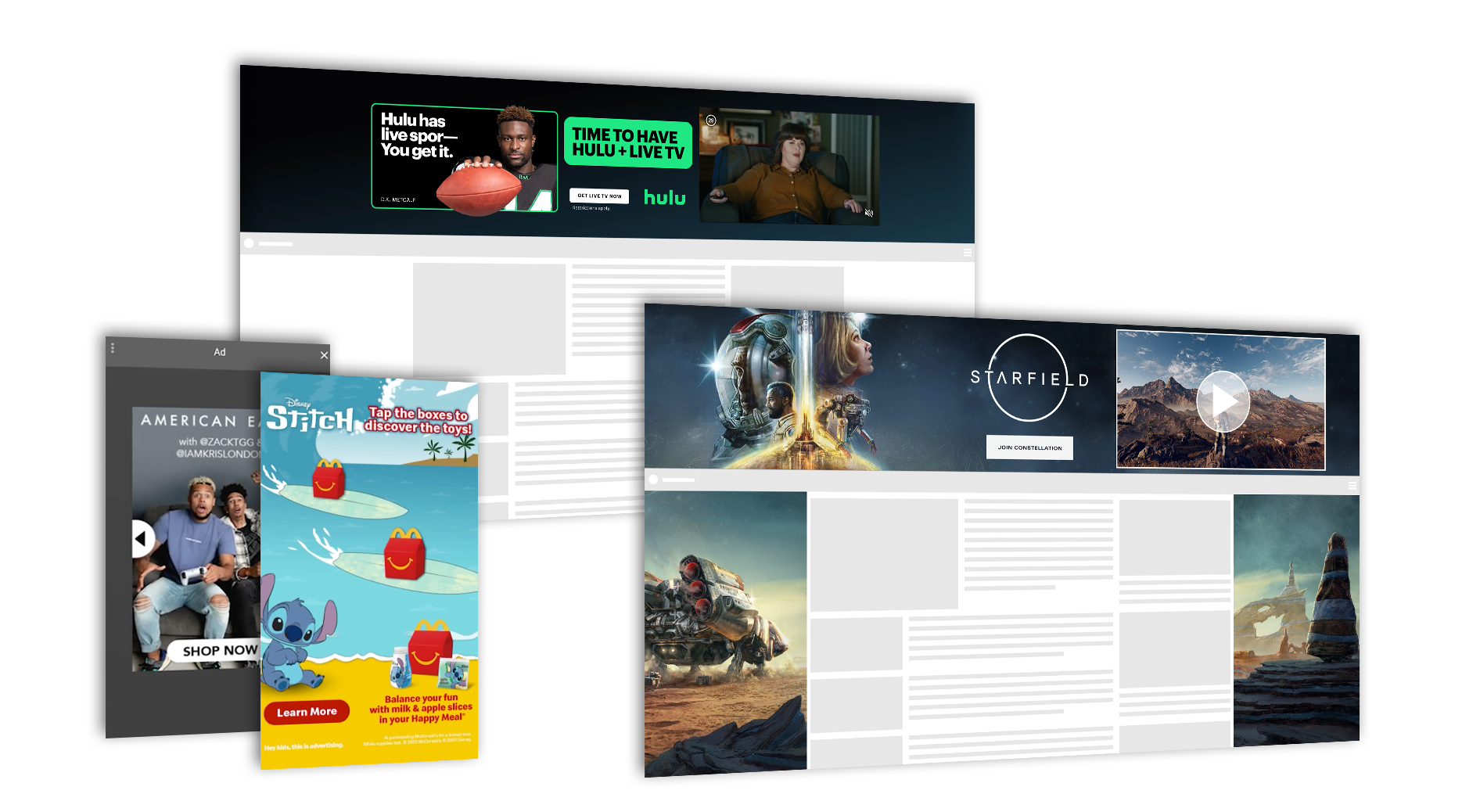How to Make Your Website Attractive for Direct Sales
April 12, 2023
Editorial Policy
All of our content is generated by subject matter experts with years of ad tech experience and structured by writers and educators for ease of use and digestibility. Learn more about our rigorous interview, content production and review process here.

Key Points
- Making your website attractive for direct sales goes beyond brand safety. There’s a whole bag of tricks that go into building a sustainable relationship with premium brands and buyers in order to maximize the value of your inventory.
- There are things you can do to increase the value you bring to a direct deal. These include providing unique data, consent management capabilities, and custom creatives.
- While there are some measures you can take to improve your site’s attractiveness on your own, having a revenue partner with a dedicated direct sales team (like Playwire) is an invaluable asset.
We’re not trying to pick a fight, but this has to be said…
If you’re not focusing on direct sales, you’re missing out on huge revenue potential.
Programmatic advertising is great, but if you really want to pack a punch when it comes to ad revenue, you need to have a solid direct sales strategy as well.
Most think being brand-safe and having good performance data is enough to secure the championship belt. It’s not.
When it comes to direct sales, there are many potential points of failure. But that doesn’t mean you have to roll with the punches. Sometimes you need a skilled team (that’s us, by the way) to champion your interests.
In this article, we’ll weigh in on everything your team can do to make your website more attractive for direct sales. And, what we can do together to really perfect your left hook.
Ready to rumble? Then keep reading.
-- Article Continues Below --
Get Your Custom Ad Layout Recommendations
What Makes a Website Attractive for Direct Sales?
Before you even step into the sparring ring, you need to get a few essentials. We’re talking gear: gloves, mouth guard, headgear, etc.
We’re talking foundation. Things that can help advertisers feel confident they are not buying inventory on a fraudulent, unsafe, or inappropriate site. It helps them ensure good ad viewing experiences for each prospective customer and streamlines ad ops from the demand side.
Here’s what strength looks like —
Safe Inventory
Just because your site is brand safe, doesn’t mean you’re being listed as such. And landing on any exclusion list, lists of URLs or keywords that major holding companies maintain for vetting safe supply, can be a KO for your site’s revenue goals.
Not to mention, most publishers are often left in the dark regarding whether or not their site has landed on any exclusion lists. In fact, you’ll need to work with a partner like Playwire, who has long-standing industry-wide relationships, to get access to this type of information as well as the tools to fight for you, if necessary.

Picture this: you have your sights set on a premium brand that aligns perfectly with your content. You take all the necessary steps to ensure your content is brand safe. Still, something is blocking you from being able to connect with this brand.
So, what’s the problem?
It turns out a third-party tracking company, like IAS, flagged you. The trigger? A negative comment on your website that mentioned the brand.
The buyer picked up a no-no phrase in user-generated content on your site and automatically added your entire site to one of their exclusion lists. Because this advertiser excludes all publishers on their blocked list, you’re now being blocked from any direct or programmatic deals with them.
Bottom line: Safety always comes first. That’s why publishers and advertisers have vetting processes to minimize risk when buying or selling.
You probably know to focus on safety. Keeping in mind that there are some things you may not be able to control on your own, there are still tons of measures you can take to ensure your site is as safe as it can be such as —
- You meet all advertiser brand safety guidelines: Be prepared for a content review. Auditors will want to confirm your content aligns with the advertiser’s values. This means no copyright infringement or NSFW-style content.
- Ad fraud risk is nonexistent: When your site is vetted for fraud risk, current and historical information matters. The vetting team will audit your code, analyze ownership and operation, and look for previous violations, scandals, or concerns. Website traffic sources are also a factor, as sites with a high volume of paid traffic or traffic coming from regions associated with fraud are considered higher risk.
- Your site is focused on creating a positive user experience: Things like pop-ups, politicized content, and even poor website design are big fouls. Media buyers or brands will also consider language cohesion and the relevance of political views with their target demographics.
- Your site has appropriate ad density:Finally, and this is a biggie, ad clutter. We created a great resource, which includes best practices for reducing ad clutter and ad density on your website. You’ll definitely want to check it out to ensure you are already taking all the proper steps you can to reduce ad clutter and manage your ad density.
- Your performance data is clean and tells a positive story: The historical data of your site will be used to assess a few things. First, it can eliminate your site from buying lists in the first round if it doesn’t reflect well on your inventory. If you make it through the first round, advertisers can use your data to strategize and create more successful campaigns.
Performance
Performance is key for all ad sales, but direct sales will take a more nuanced and big-picture approach, versus programmatic where numbers are king.
If you’re just placing ads for the sake of selling ad real estate, you’re basically swinging in the dark.
To make sure each move lands, you need to be precisely focused on user experience. Ads should never be intrusive or unwarranted if you want to move the needle from a performance standpoint.
You really want to think like the advertiser here. When it comes to direct deals, advertisers aren't going to be interested in placements where nobody looks. They want placements that are both prominent and seamlessly work with the user experience.
That means the need to be —
- Viewable: Viewability is a proxy of attention to an advertisement. If you don’t see an ad, the likelihood that you’re going to take an action related to that ad is zilch.
- Engaging: Time spent is the next most important metric from both a content and advertising standpoint. An ad can be in view, but if no one is engaging with it, what’s the point? The goal is higher video completion rates (VCR) or click-through rates (CTR).
Some additional things to look at include scroll behavior on your site and ensuring ads are placed near the spaces on your site that visitors spend the most time.
If you can perform well in these areas, you’ll be recession-proof. Sold-out tickets to every match. If you can’t, you’ll need a great sales team behind you to sell the dream.
Data and Consent Management
This is where things start to get tricky.
Advertising is global, and things like the General Data Protection Regulations (GDPR) have plagued advertisers and publishers since the beginning of digital advertising but even more so in recent years. If you don’t have a solid consent management platform integrated and a stellar team of data and consent experts that have your back, you’ll probably end up on a losing streak.
Consent is vital to the growth of any site, and while this trend started in Europe, it’s getting murkier in the U.S. From each state writing its own consent framework to the increasingly complex COPPA laws (which apply to sites directed toward children), such as the potential arrival of COPPA 2.0 and the threats it poses to online advertising, you need to understand the privacy laws that apply to your business.
Without a solid understanding of these laws, you can kiss your open exchange ad revenue goals goodbye, too. If a brand can’t use its first-party and CRM data, it’s not going to transact, at least not anywhere near the highest value.
Conversely, if you have consent from their target audiences, brands are willing to pay a premium.
-- Article Continues Below --
COPPA Compliance Training for Publishers
More Ways to Add Value to Attract Direct Sales
Once you have the essential gear, it's time to hone your technique.
If you can master a signature combo, you’ll have what you need to take home the win.
Here are some moves to get you started —
Maximize Your Revenue with Custom Campaigns
Standard creative alone isn't the best way to maximize revenue. Buyers just won’t look to direct sellers to run their campaigns if they can buy the same impression on the open exchange for much less.
Custom high-impact campaigns are the best way to drive premium revenue for publishers and premium performance for advertisers. Think custom flex leaderboards or flex skin ad units. These types of units skyrocket performance for everyone involved, meaning by not having them, you’re doing your site a huge disservice.

Keep in mind, custom high-impact campaigns are really difficult to do, and not everyone has the ability, the time, or the team, to build and sell them. Working with a partner, such as Playwire, gives you unique access to everything and everyone you need.
Add Value with Registration Data
Data, in general, is attractive to advertisers, but right now, there’s a heavy focus on preparing for a cookieless future. This means publishers have the potential to deliver value with registration data via cached emails and user profiles.
Both publishers and advertisers can exercise more sophistication in targeting solutions using this data, and Playwire is uniquely positioned to support this because of the large quantity and wide variety of sites in our portfolio. Using this first-party data as well as our unique, custom audience segments, you’ll be able to reach users in a more holistic, human way that feels authentic and engaging.
Improve Your Reputation with PR and Marketing
Advertising your platform, and championing your website and content, can make a big difference in your direct sales demand, but it’s no simple feat to do so. If you can’t clearly, and publicly, define why advertisers should buy your inventory and not one of your competitors, you’re not going to do well.
Not only will positive public relations and marketing increase traffic by attracting new visitors to your site, but it will also cultivate a positive reputation that could gain the attention of premium advertisers.
Know Your Audience
Having a strong grasp of the demographics of your visitors can help you appeal to the specific needs of each advertiser. For instance, many digital advertisers are beginning to prioritize Diversity, Equity, and Inclusion (DE&I) goals and would find a lot of value in having access to the very specific audiences they want to reach.
Knowing your audience well and having the ability to provide detailed metrics about who is coming to your website to potential advertisers is a must-have in the great ad revenue fight of 2023.
Playwire Makes You the Champ of Direct Sales
Once you master brand safety, performance, consent management, and providing unique value, you might be ready to step into the ring.
However, the list of potential points of failure when working with a particular buyer is extensive. If you don’t have a strong coach in your corner, you could see a significant loss in revenue.
Playwire is ready to make you a champion.
We have the technology, data, specialized support teams, and killer instinct to deliver real results for your direct sales goals. Contact us today to get started.

-1.png?width=800&height=157&name=1-playwire-logo-primary-2021%20(1)-1.png)





